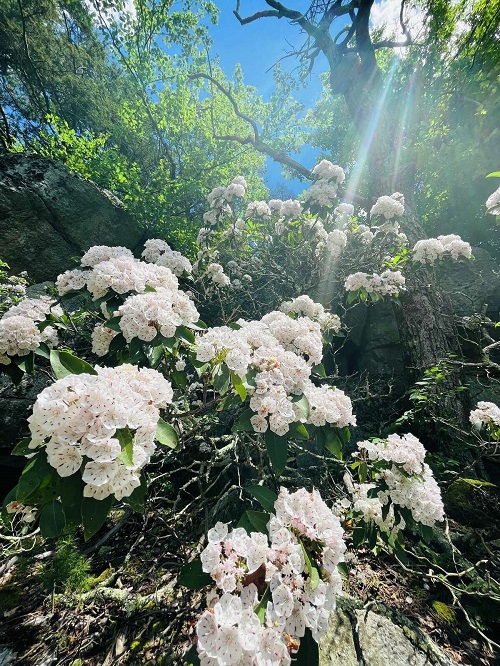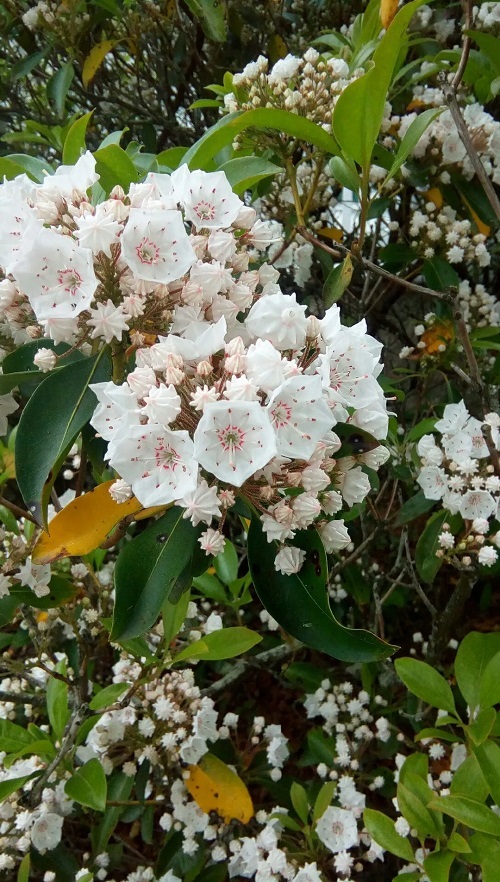Here is everything about the Connecticut State Flower and How to Grow It! Read on if you want to grow it with ease.

Dive deep into Connecticut State Flower and How to Grow It. Learn facts, growth habits, caring, and much more about this amazing flower with this quick and easy guide.
Arizona State Flower and How to Grow It
Connecticut State Flower Information
Connecticut’s cherished state flower is the Mountain Laurel (Kalmia latifolia).
- Appearance: The Connecticut State Flower is an evergreen shrub known for its captivating clusters of showy, bell-shaped flowers. The blossoms are often two-toned, with colors ranging from white to shades of pink, and are complemented by glossy, leathery leaves.
- Blooming Season: Mountain Laurel typically blooms in late spring to early summer, usually from May to June. During this period, the shrub becomes adorned with a profusion of flowers that create a breathtaking display in Connecticut’s wooded landscapes.
- Height: Mountain Laurel typically grows to a height of 5 to 15 feet, although it can sometimes reach up to 20 feet or more in ideal conditions.
- Spread: The spread of Mountain Laurel is usually about the same as its height, ranging from 5 to 15 feet wide.
- Significance: The Connecticut State Flower holds symbolic significance in Connecticut, representing beauty, endurance, and the state’s natural heritage.
- Cultural Impact: This native plant has deeply rooted cultural significance among Native American tribes and early settlers. Its tough wood was used by Native Americans to create hunting bows and other tools, while its distinctive flowers have been celebrated in various art forms.
- Legislation: In 1907, the Mountain Laurel was officially designated as the Connecticut State Flower through legislative action.
- Conservation: Conservation efforts are in place to protect and preserve the Mountain Laurel in Connecticut. The state’s commitment to maintaining its natural landscapes helps ensure the continued growth and survival of this iconic shrub.
USDA Zones: 5-9
Texas State Flower and How to Grow It
USDA Zones of Connecticut State
Connecticut, being in the northeastern part of the United States, falls within several different USDA Zones, reflecting the state’s varied climate.
1. USDA Zone 5b
- Temperature Range: -15 to -10°F (-26.1 to -23.3°C)
- Location: This zone is found in some of the colder, more northern parts of the state and higher elevations.
2. USDA Zone 6a
- Temperature Range: -10 to -5°F (-23.3 to -20.6°C)
- Location: This covers portions of northern Connecticut, extending down to parts of central Connecticut.
3. USDA Zone 6b
- Temperature Range: -5 to 0°F (-20.6 to -17.8°C)
- Location: A significant portion of central Connecticut falls within this zone.
4. USDA Zone 7a
- Temperature Range: 0 to 5°F (-17.8 to -15°C)
- Location: This zone includes the coastal areas and parts of southern Connecticut, where the climate is milder.
5. USDA Zone 7b (in some areas)
- Temperature Range: 5 to 10°F (-15 to -12.2°C)
- Location: Some very specific coastal regions may even extend into this warmer zone.
How to Grow Connecticut State Flower
Mountain Laurel propagation can be achieved through several methods, including seeds, cuttings, and layering. The easiest way to grow the Connecticut state flower is from seeds. Follow the steps below.
Best Time: Late fall to early winter.
- Collect mature seeds from existing Mountain Laurel plants in late summer.
- Place the seeds in a sealed plastic bag with a damp paper towel or sphagnum moss.
- Refrigerate the bag for about 6-8 weeks to simulate the cold stratification process the seeds experience in nature.
- Fill a seed tray with a well-draining mixture of peat moss and sand or a seed-starting mix.
- Gently press the stratified seeds onto the surface of the soil and cover the seeds lightly with a thin layer of soil or sand.
- Mist the soil surface to ensure even moisture without over-saturating. Cover the tray with a clear plastic dome or plastic wrap to create a mini greenhouse effect.
Once seedlings have developed a few leaves, gently transplant them into individual pots with a similar soil mixture.
Cuttings:
- Best Time: Mid-summer to early fall.
- Notes: Semi-hardwood cuttings are usually taken in this period. Cuttings should be treated with rooting hormone and placed in a mixture of peat and perlite or other well-draining medium. Bottom heat and humidity control can improve success rates.
Layering:
- Best Time: Spring through early summer.
- Notes: Layering involves bending a branch to the ground and covering a part of it with soil, often after wounding the bark slightly. The buried section will eventually form roots and can be severed from the parent plant.
Expert Tricks to Germinate Seeds Faster
Best Pot Size for Connecticut State Flower

Opt for a container that provides ample room for root growth, typically a pot with a diameter of 12 to 16 inches. This size allows for proper moisture retention and offers enough space for the Mountain Laurel’s root system to develop, promoting healthier growth and vibrant blooming.
Remember to select a pot with good drainage to prevent waterlogging and maintain the plant’s well-being.
Here are Plant Pot Sizes from Inches to Gallon
Requirements for Growing Connecticut State Flower

Sunlight
- Intensity: Mountain Laurel thrives in partial to dappled sunlight. Provide it with filtered sunlight or a few hours of direct morning sunlight, avoiding the intense midday sun.
- Location: Choose a planting location that offers a balance of sun and shade. Plant the Mountain Laurel in an area where it receives morning sun and afternoon shade or under the canopy of taller trees that provide dappled sunlight.
Soil
- Type: The Connecticut State Flower thrives in well-draining, acidic soil. Choose a soil mix that is rich in organic matter, such as peat moss or compost, to ensure proper drainage and moisture retention. Avoid heavy or clayey soils that can lead to waterlogged conditions.
- pH Level: Maintain a soil pH level in the range of 4.5 to 5.5 for optimal growth of Connecticut State Flower. This acidic pH range supports nutrient availability and root health.
Water
- Frequency: Water the Connecticut State Flower consistently keeps the soil evenly moist, especially during its active growth period in spring and early summer. Aim for deep, thorough watering sessions whenever the top inch of soil feels dry to the touch.
- Method: Water the Mountain Laurel plants at the base, directly onto the soil, rather than overhead. Use a soaker hose or a drip irrigation system to deliver water slowly and evenly to the root zone.
Temperature
- Range: The Connecticut State Flower is hardy across USDA zones 5 to 9, withstanding a temperature range of approximately -20°F to 20°F (-29°C to -6°C) in winter and enjoying milder summer conditions.
- Protection: Provide protection against harsh winter conditions, especially in colder regions. Mulch around the base of the plant with a layer of organic material, such as straw or wood chips, to insulate the roots and protect them from cold snaps.
Note: In extremely cold climates, consider covering the Connecticut State Flower with burlap or a frost cloth during winter to shield it from drying winds and prevent damage to foliage and buds.
Connecticut State Flower Care

Fertilizer
Fertilize the Connecticut State Flower, Mountain Laurel, with a balanced, slow-release fertilizer specifically formulated for acid-loving plants. Apply the fertilizer in early spring, before new growth begins, and again in late spring after flowering.
Avoid excessive nitrogen, which can lead to excessive foliage growth at the expense of blooms.
13 Things that Come from Your Blender that Can Fertilize Your Plants
Pests
- Rhododendron Borer: Larvae bore into stems, weakening the plant.
- Azalea Lace Bug: Feeds on leaves, causing stippling and discoloration.
- Scale Insects: Attach to branches and leaves, siphoning sap and weakening the plant.
- Spider Mites: Tiny pests that spin webs and cause leaf discoloration and damage.
- Twig Blight Fungus: Causes dieback and twig lesions, affecting plant vigor.
Diseases
- Phytophthora Root Rot: Causes root decay, leading to wilting and decline.
- Powdery Mildew: Fungal infection that creates a powdery white coating on leaves.
- Leaf Spot: Fungal disease causing circular lesions on leaves.
- Botryosphaeria Dieback: Fungus leading to twig dieback and cankers.
- Leaf Blight: Causes brown, irregular lesions on leaves.
- Cercospora Leaf Spot: Fungal infection resulting in dark spots with yellow halos.
Connecticut State Flower – FAQs
1. What Is the Significance of the Mountain Laurel as Connecticut’s State Flower?
The Mountain Laurel represents enduring beauty and Connecticut’s natural heritage. Its captivating blossoms symbolize the state’s appreciation for both aesthetic charm and native flora.
2. When Does the Connecticut State Flower Bloom in Connecticut?
The Connecticut State Flower typically blooms from late spring to early summer, usually from May to June. This period showcases the plant’s stunning clusters of bell-shaped flowers.
Illinois State Flower and How to Grow It
3. How Can I Protect Connecticut State Flower From Pests and Diseases?
Regularly inspect your Mountain Laurel for signs of pests like lace bugs or diseases like powdery mildew. Implement preventive measures such as proper spacing, good air circulation, and using appropriate treatments to maintain the plant’s health and vitality.


